Top News

October 1, 2018 Ryukyu Shimpo
The new Naha bus terminal, the latest gateway on the island, opened its doors at 5 a.m. on October 1.
The terminal was greeted with a strong turnout starting in the morning hours on opening day.
Alongside the commuters were many spectators who wished to get a glimpse of the new terminal.
The new terminal houses 11 stops, connecting passengers with over 65 routes serviced by companies including Naha Bus, Ryukyu Bus Kotsu, Okinawa Bus and Toyo Bus. The terminal is operated by Naha Bus Terminal, a wholly owned subsidiary of Daiichi Kotsu Sangyo.
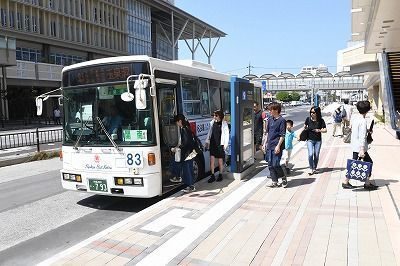
Passengers file into a bus at the now-operational Naha Bus Terminal on the morning of October 1 at Izumizaki, Naha City.
Information, such as schedules, is displayed on the electronic bulletin board in multiple languages, including English, Korean and Chinese, making it accessible for tourists.
The terminal is handicap-accessible and the facility offers an air-conditioned indoor waiting area as well as a convenience store.
Mieko Miyazato, 82, is a Naha local who regularly uses the bus as a means of transportation.
She wasted no time in visiting the terminal to obtain a timetable for lines running through Naha city.
“The new terminal is handicap-accessible and it’s senior-friendly. It’ll make going out more enjoyable,” Miyazato said with a smile.
Nathan Wallster, 33, a tourist from the United States told us, “The schedules and destinations are displayed in English, which allows me to take the bus without confusion. The facility is clean and comfortable as well.”
(English translation by T&CT and Monica Shingaki)
Go to Japanese

September 26, 2018 Ryukyu Shimpo
Washington Special Correspondent Yukiyo Zaha
On September 24 the plaintiffs in the dugong lawsuit, who requested a stop to construction of the Futenma Replacement Facility in Henoko, Nago City, appealed to the Federal High Court after the San Francisco District Court dismissed an appeal of the lawsuit.
U.S. and Japanese environmental conservation groups brought this case against the United States for the purpose of protecting endangered dugongs. The High Court will soon judge to accept or reject this appeal.
One of the plaintiffs, Peter Galvin of the Center for Biological Diversity issued a statement that said, “This could be the last chance to save the dugong.
The court should compel the U.S. military to follow the law and not wipe out these amazing animals.”
This lawsuit was initiated in 2003 against the U.S. Department of Defense. In February 2015, the district court dismissed the plaintiffs’ request for an injunction raised political questions the court lacked the authority to hear.
In August 2017 the appeal court dismissed the district court’s decision, acknowledged the plaintiff’s claim, and sent the case back to the district court.
However, in August this year after the lawsuit was filed, the first substantive public hearing admitted the U.S. government’s assertion.
Regarding the procedure based on the U.S. National Historic Preservation Act, “The defendants sufficiently considered the influence [of construction] on dugong.”
(English translation by T&CT and Megumi Chibana)
Go to Japanese
October 1, 2018 Ryukyu Shimpo
The Okinawa gubernatorial election, held after the passing of Governor Takeshi Onaga, was won by former Diet member Denny Tamaki, 58. Tamaki, an opponent of the new U.S. military base construction in Henoko, Nago, defeated by a large margin the Abe administration-backed former mayor of Ginowan, Atsushi Sakima, 54.
During the election, Tamaki took the position of using his authority as governor to block the new base construction in Henoko, which is part of the relocation of MCAS Futenma, stressing, “I will not allow a new base in Henoko.”
His opponent, Sakima, was fully backed by the Abe administration, which is pushing for the Henoko relocation, however he refused to state his own position regarding the hot-button issue.
Tamaki’s landslide victory once again made clear the firm resolve of Okinawan’s opposition to the new base construction.
The central Japanese government should heed the clear message sent by the electorate for the second straight time in a gubernatorial election, and immediately cease construction of new base facilities in Henoko.
70% of all U.S. military land in Japan is concentrated in Okinawa, the most prominent of which is Kadena Air Base, which comprises an area four times the size of MCAS Futenma.
It is not an outrageous demand to request that the return of the land occupied by MCAS Futenma not lead to new military facilities within Okinawa.
During this election the ruling government coalition sent Chief Cabinet Secretary Yoshihide Suga, Liberal Democratic Party (LDP) Secretary General Toshihiro Nikai, LDP General Council Chairman Wataru Takeshita, and Komeito Party House of Councillors member Natsuo Yamaguchi to Okinawa in a full-scale effort to support Sakima.
Almost as if in coordination with the ruling coalition, slander and disinformation about Tamaki was also scattered all over the internet.
Even certain members of the Diet, who are supposed to lead by example, disseminated information of dubious quality.
In an Okinawan gubernatorial election, there has probably never been a candidate baselessly vilified to the extent experienced by Tamaki. It is likely that some of this information was believed by some voters as being true.
After World War II, the first time during U.S. military rule that a public election to directly select leaders to represent residents in Okinawa was 1968. It was a right fought for by Okinawans demanding expanded autonomy.
At that time, the LDP power-players like Shojiro Kawashima, Takeo Fukuda, and Yasuhiro Nakasone would come to Okinawa to strongly support the conservative candidates. The result was the election of the reform-minded Chobyo Yara as Chief Executive of the Ryukyu Islands.
It has been 50 years since then.
Japan’s ruling party intervened in the gubernatorial election and were defeated.
If we assume that they thought this candidate promotion plan would go as planned, wouldn’t it seem that they are looking down on Okinawans?
In the current situation in Okinawa, where the national ruling party and the prefectural ruling party are in staunch opposition, the people of Okinawa have clearly stated their wish to continue on the path set by the Onaga prefectural administration and have sent a resounding “NO!” back to Abe’s central government. The statement is loud and clear, “Okinawa will not just do what the central government tells us, we will decide what happens in Okinawa ourselves!”
The permission for land reclamation in Henoko Bay was revoked by Governor Takeshi for Okinawa August 31.
Japan’s government is looking to take legal action to overturn this.
At this juncture, if the new bases are continued to be imposed on us, Japan will no longer qualify as a democratic country.
The central government should respect the unshakeable will of the people of Okinawa and abandon the new base construction.
(English translation by T&CT and Sam Grieb)
Go to Japanese
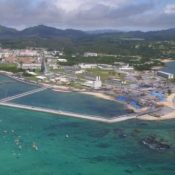
September 19, 2018 Ryukyu Shimpo
Over the course of three days starting on September 14, the Ryukyu Shimpo conducted a telephone public opinion poll jointly with the Okinawa Television Broadcasting Company (OTV) and JX Press Corporation.
The poll revealed that about 70 percent of those asked support the Okinawa Prefectural Government (OPG) in its revocation of land reclamation approval relating to the new base being constructed in Henoko.
Only about 20 percent of respondents answered they do not support the revocation.
This is yet another indicator of Okinawans’ determination to block construction of the Futenma replacement facility in Henoko.
On August 31 the OPG revoked land reclamation approval, and this is the first time Okinawans’ thoughts on this decision have been demonstrated.
In the poll, 56.8 percent of respondents said they “strongly support” revocation, and 12.5 percent said they “somewhat support” it.
On the other hand, 12.1 percent of respondents said they “don’t support [revocation] at all,” and 9.2 percent said they “somewhat don’t support” it. Out of respondents 9.4 percent answered they were “undecided.”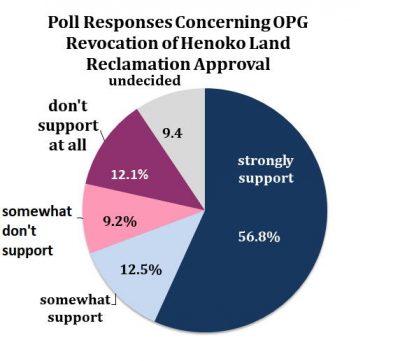
If responses are parsed out in terms of age groups, the ages with the highest ratio “strongly supporting” the revocation were in their 70s, 60s, 80s, 50s, 30s, and 40s in descending order.
The ages with the highest ratio of “don’t support [revocation] at all” responses were in their 20s, 30s, and 40s in descending order.
In terms of political parties, independent voters had the highest ratio of “strongly support” responses.
The most people to respond they “don’t support [revocation] at all” were LDP voters, but a portion of them also supported the revocation.
Komeito voters supporting revocation outnumbered those who do not.
In terms of gender, more women than men answered that they “strongly support” revocation, and only slightly more men than women said they “don’t support [revocation] at all.”
On July 27 in an interview the late Takeshi Onaga, governor of Okinawa at the time, he first announced that he would pursue procedures to revoke former governor Hirokazu Nakaima’s land reclamation approval for construction of the Henoko base.
Following Governor Onaga’s death, on August 31 in accordance with Onaga’s wishes the land reclamation approval was revoked based on the Public Water Body Reclamation Act.
(English translation by T&CT and Erin Jones)
Go to Japanese

October 1, 2018 Ryukyu Shimpo online edition
On October 1 local citizens opposing construction of the Henoko base held a protest in front of the gate to Camp Schwab.
Protestors raised their voices in support of Denny Tamaki, who was just elected governor of Okinawa on September 30 and who ran on the platform of blocking Henoko base construction.
They said things like, “We have shown the willpower of the Uchinanchu” and “Let’s support the new governor.”
Around 8:00 a.m. on October 1 about 70 citizens gathered in front of the gate.
Co-representative of the Helicopter Base Objection Association Hiroshi Ashitomi spoke about the election of Tamaki at the gathering.
He said, “This is the result of Okinawans taking on the wishes of Governor Takeshi Onaga as their own.”
The gathered citizens shouted “banzai” in celebration of Tamaki’s election.
Some were seen enthusiastically embracing each other or shaking hands.
(English translation by T&CT and Erin Jones)
Go to Japanese

September 25, 2018 Ryukyu Shimpo
By Chie Tome
“OK, one, two, three, four.” With a commanding tone, Yoshio Kinjo, 83, from Tomigusuku leads the 17-person big band, “Y.K. Singing Orchestra.” Kinjo was introduced to the drums in 1954, in his senior year of high school.
He has been playing them ever since in a musical career that spanned over 60 years, running at the forefront the world of Okinawan jazz.
Kinjo had an interest in music ever since he was a child, and he joined the concert band while attending Naha High School. At first, he was a standout in the trumpet section, but as an upperclassmen he was discovered to have talent on the drums and switched over.
“Whether I was asleep or awake, all I thought about was music,” Kinjo said of his senior year, when he formed a band with six other concert band members and spent all of his time not on schoolwork performing at nightclubs and cabarets.
It was at that time that he was discovered by talent scouts and officially formed a band called, “Crazy & Cool.” He decided to make his living playing music.
Before the reversion of Okinawa to mainland Japan, Kinjo would also occasionally perform at clubs inside the U.S. military bases.
Particularly, in the 60’s at the height of the Vietnam War, he toured around dancehalls in places such as Rycom Officer’s Hall, Henoko, and Kin, playing music for U.S. soldiers and girls to dance to.

Yoshio Kinjo (center back) performing with his band at clubs and cabarets when he was a senior at Naha High School. 1954, at the Taihokan in Naha
“I think we were playing to help the soldiers, who could be called to the front lines at any time, find some relaxation.
The pay was also triple that of your average salaryman,” Kinjo reflected.
After the reversion, he switched to playing tunes from the Okinawa Symphony Orchestra and Chieko Iha.
In 1979, he appeared on the Okinawan jazz record, DAH NAH with the Ryusei Tomoyose Quartet, and participated as a consultant on Okinawa Jazz Kyokai’s first album Uchina Jazz! He sought new possibilities for the American-born style of music in Okinawa.
Currently, Kinjo periodically performs concerts with the “Y.K. Singing Orchestra” which was established in 2015, and puts a lot of effort into cultivating young musicians.
Kinjo continued to watch the evolution of the Okinawa jazz scene over the years.
Looking down at the hands that drummed out the rhythms over generations, he said smiling gently, “All my life all I have known is jazz, so I want to continue until the very end.”
(English translation by T&CT and Sam Grieb)
Go to Japanese
September 27, 2018 Ryukyu Shimpo
During the plenary session of the Tokyo Prefecture Koganei City Council on September 25, the council members came to a decision via majority vote on the petition regarding the Henoko base issue.
Specifically, the petition calls for discussing, as a nation, the transfer of the U.S. Marine Corps Air Station Futenma outside of the prefecture or country and to come to a decision after fair and democratic paperwork.
The petition also calls for making all municipalities of the nation equal candidate sites and “to conduct national discussions with a sense of ownership” while immediately canceling the construction of the new base in Henoko, Nago City.
The petition is based on the “New Proposals” by individuals interested in preventing the new Henoko base construction.
This is the first time it was adopted in Japan. In August, 30-year-old Seishin Komesu, who is originally from Okinawa, but currently lives in Koganei City, filed the petition to the city council.
The petition was deliberated during the plenary session on September 25 after passing through the city council’s Planning and Coordination Committee on September 20.
Excluding the chairman, 23 council members took a vote.
It was a majority vote where 13 were in favor from the Communist Party and other parties, 6 against from the Liberal Democratic Party, and 4 abstained from the Komei Party.
Following the vote, the city council is to create a proposal based on the petition and will hold a vote on October 5 during the plenary session.
It is predicted that the council will pass the proposal with a majority vote.
The petition lays out democratic and fair steps to resolve the new Henoko base construction issue.
It calls for specific methods, such as 1) calling off the construction of the new Henoko base and discontinuing the operation of the Futenma Air Station, 2) conducting a national discussion with a sense of ownership on whether or not U.S. military bases and alternative facilities are needed, and 3) if they are needed, then based on democratic and constitutional mentality, decide by fair and democratic paperwork.
People from Okinawa urge the city council, “Uneven distribution of the bases is discrimination”
Komesu made his rounds to the different parties and factions of the council to explain the objective of the petition, asked for consideration, and made a statement to the reviewing committee.
There were many council people who were a party of one, to which he said, “The government’s ruling and opposition parties not having a political environment that is systemized is a huge factor.”
Komesu moved to Koganei City five years ago.
He exchanged opinions via SNS with Nagatsugu Asato, a 46-year-old judicial scrivener (paralegal) who works to resolve base issues with fair and democratic resolutions. Komesu “identified” with Asato’s activities.
He decided to file the petition after reading a book published in May by Asato and others.
He felt that there was something he could do in the city he lived in as an Uchinanchu living in Tokyo.
At the time, he even intended to encourage policy debate in preparation for the prefectural governor election that was originally planned to take place in November.
While he was making his rounds to each party and fraction, a particular exchange with a centrist council person he had encountered left an impression on him. As they moved to and continued their discussion at an izakaya (Japanese restaurant bar), the council person, who approves of the Japan-US Security Treaty, gradually began to side with Komesu’s argument that the “uneven distribution toward Okinawa is discriminatory.”
Even during the vote, the individual sided with those in favor.
Petition items are typically carried over to the next session.
However, a vote was reached with this petition about a month after it was filed.
Komesu said, “Things going this smoothly was more than I had imagined. We achieved results in an official form, namely a vote at the assembly.”
Asato who works on the “New Proposals,” pointed out, “People say we can’t gain the understanding of the mainland. However, common sense talks like discussing this as a nation and taking responsibility in the results wasn’t happening. If the idea of the proposal spreads, then the government’s ‘only in Henoko’ logic will also collapse.”
(English translation by T&CT and Chelsea Ashimine)
Go to Japanese
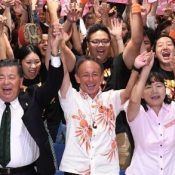
September 30, 2018 Ryukyu Shimpo
The 13th Okinawa gubernatorial election was moved up to September 30 due to the death of former governor Takeshi Onaga.
Denny Tamaki, 58, a former House of Representatives member and independent rookie candidate supported by the Okinawa prefectural government’s ruling party, won this gubernatorial race for the first time. He defeated Atsushi Sakima, 54, a former mayor of Ginowan City and independent rookie candidate supported by the ruling party of the central government, the Liberal Democratic Party, the Komei Party, Ishin Party, and Kibo Party.
Tamaki pledged to oppose the plan to relocate U.S. Marine Air Station Futenma in Ginowan to Henoko, the most significant issue in the election, and he supports Governer Onaga’s revocation of the Henoko land reclamation approval.

Click to enlarge (PDF file 4.50 MB)
This election’s results once again demonstrate the Okinawan people’s opposition to the Henoko relocation.
The central government has been promoting Futenma replacement facility construction with a hardline stance.
All eyes are on the government and its next move.
During his campaign, Tamaki touched on construction of the Futenma replacement facility in Henoko.
He said, “Nago’s citizens cannot be made to bear the suffering caused by the military base, which is currently being shouldered by Ginowan’s citizens. I will do my best to prevent the construction of the new base.”
He added, “The government should keep its promise,” in regard to the five-year period within which the Okinawa prefectural government wants Futenma Air Station closed. The endpoint of this five-year period is next February.
In response to the revocation of land reclamation approval by the prefectural government, he said, “I fully support it. [The prefectural government] revoked it by judging properly based on the Public Water Body Reclamation Act.”
Additionally, Tamaki pledged to aim to realize “a society that does not leave anyone behind,” “free childcare,” “zero waiting children,” “establishment of comprehensive support centers for child-rearing generations in all municipalities,” “assistance maintaining nursery schools and getting non-approved nurseries approved,” and “school lunch cost assistance for non-approved nurseries.”
Tamaki was born on October 13, 1959, at Yonashiro in Uruma City.
His real name is Yasuhiro Tamaki. He was a popular radio personality, but in 2002 as an aspiring politician he was elected to the Okinawa City Council for the first time. He won a seat in the House of Representatives for the first time in 2009, and served for four terms. His family consists of his wife Chieko, two sons, and two daughters.
(English translation by T&CT)
Go to Japanese
September 20, 2018 Ryukyu Shimpo
On September 7 around 10:30 p.m. in Yomitan Village, Okinawa, a U.S. soldier committed a home invasion.
It came to light on September 19 that at the time of invasion, only the daughters of the man who owns the house were home, a second-year high schooler and a 5-month old child.
The soldier who came in threatened the young woman, who was holding her little sister, that he would kill her.
She escaped out the window with her sister and took refuge in a neighbor’s house.
On September 19 Yomitan villagers and Yomitan Village Assembly made a protest to the Okinawa Defense Bureau (ODB).
Kadena police arrested the suspect, a 23-year-old army private first class soldier stationed at Kadena Air Base.
Just before the incident he had been drinking with a few people at his acquaintance’s house before he stepped outside, alone. Drunk and shirtless, the soldier struck the victim’s outside wall and car, and entered the victim’s unlocked home.
Although the elder daughter was able to escape to a neighbor’s house, she did not stop trembling.
Neither daughter was injured in the incident.
According to the Yomitan Village Office, after the incident the elder daughter was unable to attend her classes and she continued to tremble for some time. Now she seems calmer.
On September 19 at an extraordinary session of the Yomitan Village Assembly, assembly members unanimously adopted a written statement and protest resolution objecting to the home invasion incident.
The resolution states, “We absolutely cannot permit acts of barbarity to threaten the tranquil and peaceful lives of the villagers.”
It goes on to request that the vicitims be completely compensated, and that the US-Japan Status of Forces Agreement be drastically revised.
On the same day, an Assembly representative and Mayor of Yomitan Village Denjitsu Ishimine paid a visit to Chief Koichiro Nakajima of the ODB to lodge a complaint. Nakajima said, “We, too, think this is regrettable.
As for compensation, naturally we will do what we can.”
Mayor Ishimine visited Commanding Officer Theodore White of the 10th Support Group (Regional) at Torii Station, and lodged an objection with him.
Colonel White apologized and explained that anything one part of a larger organization does affects the whole structure.
(English translation by T&CT and Erin Jones)
Go to Japan

September 20, 2018 Ryukyu Shimpo
On September 19, Binkou HD, Mizuhoshuzo, and Nanto Liquor announced the completion of “Ohkoku Gongjiu (Kingdom Sake),” a new Okinawan white sake that uses raw liquor from Awamori (strong Okinawan liquor). It is intended for exportation to China and the alcohol content is 53 percent.
The product name incorporated “Baijiu (white sake),” a spirit familiar to Chinese.
Starting October 22, the product will be sold at locations where Chinese gather, such as souvenir stores concentrated on Kokusai Street, duty-free shops, and restaurants inside luxury resort hotels.
It will also be exhibited at the first China International Import Expo (CIIE) that is to be hosted in Shanghai this November to expand sales at Chinese department stores and liquor stores.
The three companies have been working on commercializing Okinawan white sake since April.
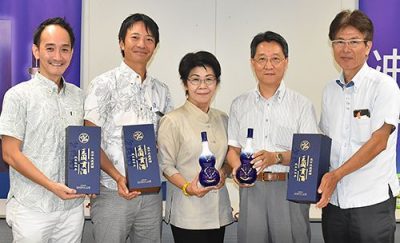
Nanto Liquor Co., Ltd President Kentaro Ohiwa (second from left), Mizuhoshuzo Co., Ltd President Misako Tamanaha (third from left), and Binkou HD Co., Ltd Managing Director Hidekoshi Nakahara (forth from left) introducing “Ohkoku Gongjiu” on September 19 at the Okinawa General Bureau in Naha City
Binkou HD handled expanding into China, Nanto Liquor handled sales geared toward visiting foreign customers, and Mizuhoshuzo handled producing the liquor.
The target is to sell 100 kiloliters in and outside of Japan by 2022.
Nanto Liquor President Ohiwa said, “Since it has been recognized within the prefecture, we will expand our business to existing routes like Tokyo and Kyoto.”
Without tax, a 500 milliliter bottle costs 15,800 yen. Crowdfunding site Makuake started advance sales on September 19.
(English translation by T&CT and Chelsea Ashimine)
Go to Japanese
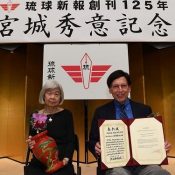
September 16, 2018 Ryukyu Shimpo
On September 15, the Ryukyu Shimpo presented the Ikemiyagushiku Shui Award to the group that gathered signatures of 103 international scholars and activists onto an international statement in opposition to the Futenma replacement facility being built in Henoko, Nago City.
About 300 people attended the presentation ceremony and symposium held at Ryukyu Shimpo Hall in Izumizaki, Naha City.
The president of the Ryukyu Shimpo, Yasutaka Hanashiro, presented supporters of the statement with the award certificate and prize money of one million yen.
American University Professor Peter Kuznick of the United States and poet and novelist Joy Kogawa of Canada received these momentos.
Kuznick, who took on a leadership role in handling the statement, said that everyone fighting for Okinawa has given courage to people fighting militarism around the world. He insists that everyone fighting earned the Ikemiyagushiku Shui Award together.
Hanashiro said, “This has shown us that Okinawa does not stand alone. You have given Okinawans courage and hope.”
Takekuni Ikeda, an official of the Okinawa Prefectural Government (OPG), read a statement for Vice Governor of Okinawa Moritake Tomikawa. It read, “With the issuance of the statement Okinawa’s present condition was communicated to the world. I hope for further cooperation in promoting international awareness [of these issues].”
At the symposium Kuznick took the podium with Keiko Katsukata-Inafuku, a member of the award selection committee.
One of the award recipients, Satoko Norimatsu, came from Canada but was unable to attend the ceremony due to temporarily ill health.
(English translation by T&CT and Erin Jones)
Go to Japanese













 Webcam(Kokusai Street)
Webcam(Kokusai Street)


